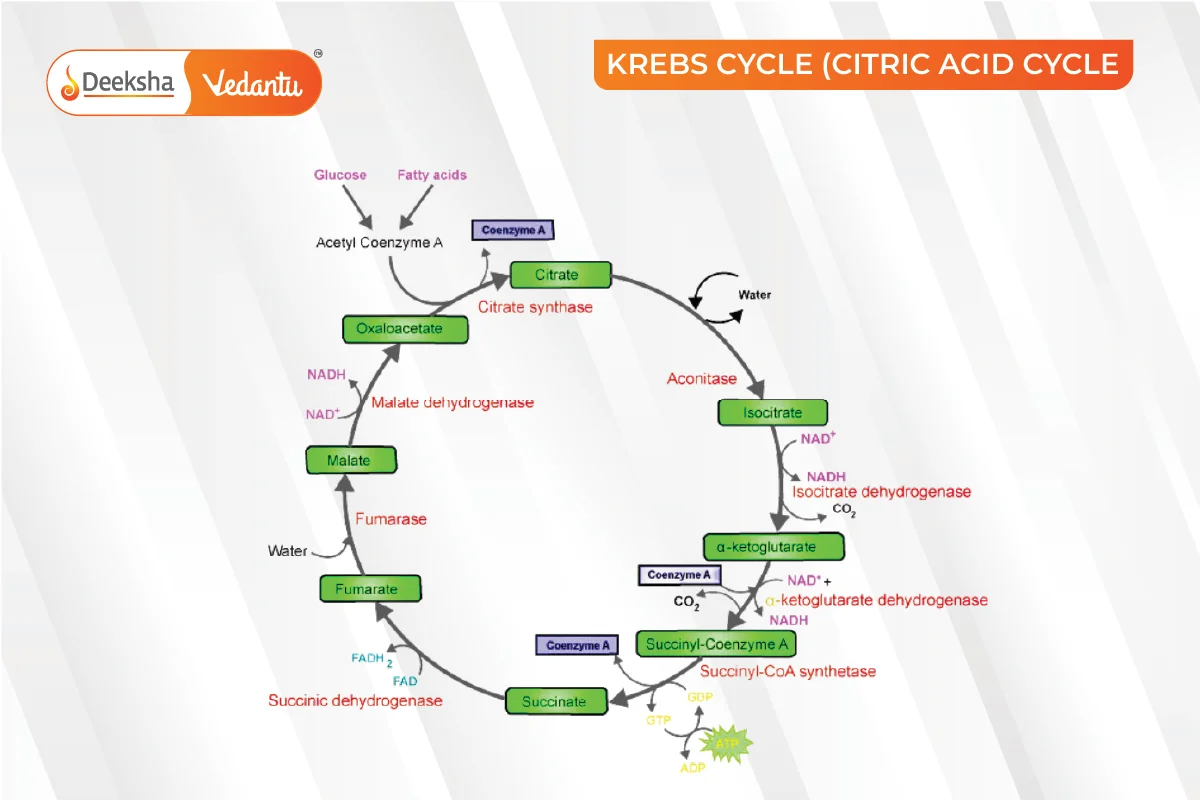Krebs Cycle or Citric Acid Cycle
The Krebs cycle, also known as the Citric Acid Cycle, consists of enzyme-driven reactions in the mitochondrial matrix where acetyl-CoA is oxidized to produce carbon dioxide and reduced coenzymes that generate ATP in the electron transport chain.
Named after Hans Krebs, who described the cycle in detail and won the Nobel Prize in 1953, it involves eight steps where acetyl-CoA is converted to carbon dioxide, producing ATP, NADH, and FADH2 in the process. Each glucose molecule results in two acetyl-CoA, so the cycle runs twice per glucose, producing four CO2, six NADH, two FADH2, and two ATP.
Krebs Cycle in Cellular Respiration
Cellular respiration, a four-stage catabolic process, breaks down nutrients to release energy stored as ATP, releasing waste products. In aerobic respiration, oxygen is essential. Each glucose molecule can produce 36-38 ATPs.
Four Stages of Cellular Respiration:
- Glycolysis: Partial breakdown of glucose into two pyruvate molecules in the cytosol.
- Formation of Acetyl CoA: Pyruvate enters the mitochondrial matrix and forms acetyl CoA.
- Krebs Cycle: Complete oxidation of acetyl CoA occurs, producing ATP, NADH, and FADH2.
- Electron Transport and Oxidative Phosphorylation: Electrons from NADH and FADH2 are transferred to oxygen, generating ATP in the inner mitochondrial membrane.
Krebs Cycle Steps
- Formation of Citrate: Acetyl CoA combines with oxaloacetate to form citrate.
- Formation of Isocitrate: Citrate rearranges to isocitrate.
- Formation of α-Ketoglutarate: Isocitrate is oxidized to α-ketoglutarate, releasing CO2 and forming NADH.
- Formation of Succinyl CoA: α-Ketoglutarate converts to succinyl CoA, releasing CO2 and forming NADH.
- Formation of Succinate: Succinyl CoA converts to succinate, producing ATP.
- Formation of Fumarate: Succinate is oxidized to fumarate, forming FADH2.
- Formation of Malate: Fumarate converts to malate.
- Regeneration of Oxaloacetate: Malate is oxidized to regenerate oxaloacetate, forming NADH.

Krebs Cycle Summary
- Location: Mitochondrial matrix
- Reactants: Acetyl CoA and oxaloacetate
- Products per cycle: 2 CO2, 1 ATP, 3 NADH, 1 FADH2
Since each glucose forms two acetyl CoA, the cycle runs twice per glucose, yielding:
- 4 CO2
- 2 ATP
- 6 NADH
- 2 FADH2
Krebs Cycle Equation
Significance of the Krebs Cycle
- Oxidation Pathway: Final stage for glucose, fats, and amino acids oxidation.
- Energy Source: Major source of ATP in cells.
- Metabolic Intermediates: Produces compounds for gluconeogenesis, lipogenesis, and amino acid synthesis.
- Role of Vitamins: Essential vitamins (riboflavin, niacin, thiamin, and pantothenic acid) function as enzyme cofactors.
- Regulation: Depends on NAD+ supply and ATP use.
- Genetic Defects: Linked to neural damage.
- Liver Function: Critical for many processes; liver damage affects the cycle significantly.
Summary
The Krebs cycle is essential for energy production in cells, producing ATP and intermediates necessary for various biochemical pathways. It operates efficiently in the mitochondrial matrix and integrates with other cellular respiration stages to fully oxidize glucose.
FAQs
Key enzymes in the Krebs Cycle include citrate synthase, aconitase, isocitrate dehydrogenase, α-ketoglutarate dehydrogenase, succinyl-CoA synthetase, succinate dehydrogenase, fumarase, and malate dehydrogenase.
NADH and FADH2 are high-energy molecules produced during the Krebs Cycle. They carry electrons to the electron transport chain, where their energy is used to generate additional ATP.
The Krebs Cycle is a key part of cellular respiration, a process that converts nutrients into energy (ATP) in the presence of oxygen. It follows glycolysis and the formation of acetyl-CoA and precedes the electron transport chain and oxidative phosphorylation.
Each turn of the Krebs Cycle produces 2 molecules of CO2, 1 ATP, 3 NADH, and 1 FADH2. Since each glucose molecule results in two acetyl-CoA, the cycle runs twice per glucose, yielding 4 CO2, 2 ATP, 6 NADH, and 2 FADH2.
The Krebs Cycle takes place in the mitochondrial matrix of eukaryotic cells.
The Krebs Cycle is crucial for energy production in cells. It produces ATP and high-energy molecules (NADH and FADH2) that are used in the electron transport chain to generate more ATP.
The Krebs Cycle, also known as the Citric Acid Cycle, is a series of enzyme-driven reactions in the mitochondrial matrix where acetyl-CoA is oxidized to produce carbon dioxide, NADH, FADH2, and ATP.
Related Topics
- Bryophytes
- Important Notes For NEET Biology – Chromosome Structure
- Plasma Membrane Structure
- Paramecium
- Connective Tissue
- Types of Fermentation
- Plasmid
- Plant Hormones
- Protozoa
- Marchantia
- What is Hemoglobin
- Important Notes For NEET Biology – Breathing and Exchange of Gases
- Important Notes For NEET Biology – Body Fluids and Circulation
- DNA Polymerases
- Nostoc









Get Social